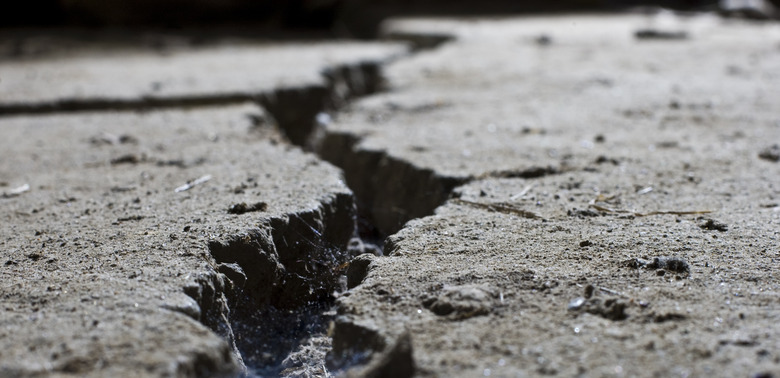What Are The Types Of Stresses In The Earth's Crust?
The Earth has three layers, the crust, the mantle and the core. The Earth's crust is like the shell of an egg; it is the thinnest of the Earth's layers. The crust is broken into several parts, known as the continental plates. When the plates are pulled or pushed together, stress occurs. Four types of stresses affect the Earth's crust: compression, tension, shear and confining stress.
Compression Stress
Compression Stress
Compression is a type of stress that causes the rocks to push or squeeze against one another. It targets the center of the rock and can cause either horizontal or vertical orientation. In horizontal compression stress, the crust can thicken or shorten. In vertical compression stress, the crust can thin out or break off. The force of compression can push rocks together or cause the edges of each plate colliding to rise. Mountains are a result of high-impact compression stress caused when two plates collided.
Tension Stress
Tension Stress
Tension is the opposite of compression. While compression forces the rocks and crust to collide and move together, tension forces the rocks to pull apart. Tension can happen in two ways. Two separate plates can move farther away from each other, or the ends of one plate can move in different directions. Some scientists think tension stress caused the ancient, massive continent Pangaea to break off into the seven continents we have today.
Shear Stress
Shear Stress
When shear stress occurs, the force of the stress pushes some of the crust in different directions. When this happens, a large part of the crust can break off, which makes the plate size smaller. Shear stress usually happens when two plates rub against each other as they move in opposite directions. The friction of a shear stress at the edges of the plate can cause earthquakes.
Confining Stress
Confining Stress
When stress is applied to all sides of the crust, confining stress occurs. When this happens, the crust compacts, which makes it look smaller. If the stress is too much for the crust to handle, the crust can fracture from the inside. This causes the crust weight to decrease but the crust shape remains the same. Because this type of stress can hollow out the insides of the crust, confining stress can cause sinkholes in the Earth.
Cite This Article
MLA
, Rebekah Pierce. "What Are The Types Of Stresses In The Earth's Crust?" sciencing.com, https://www.sciencing.com/types-stresses-earths-crust-22473/. 9 March 2018.
APA
, Rebekah Pierce. (2018, March 9). What Are The Types Of Stresses In The Earth's Crust?. sciencing.com. Retrieved from https://www.sciencing.com/types-stresses-earths-crust-22473/
Chicago
, Rebekah Pierce. What Are The Types Of Stresses In The Earth's Crust? last modified March 24, 2022. https://www.sciencing.com/types-stresses-earths-crust-22473/
